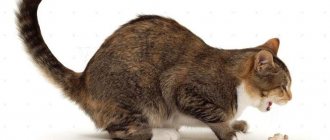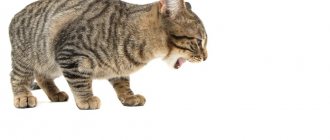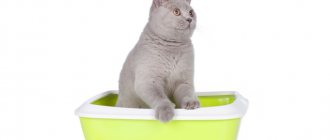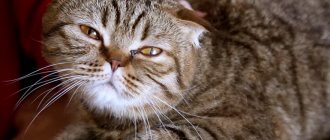The reflex that provokes vomiting is a special mechanism launched by a center in the brain and is carried out by contracting the muscle fibers of the diaphragm and peritoneum. Sudden changes in pressure inside the peritoneum cause a sharp release of stomach contents through the oral or nasal cavity.
If a cat vomits yellow liquid, this may cause problems with the pancreas, stomach, gallbladder or its ducts, as well as problems with the hepatorenal system.
The yellow color of vomit occurs as a result of the penetration of bile. In a normal physiological state, bile should not be in the stomach, since it has a pronounced ability to irritate the walls of the stomach.
In addition to the bright yellow color, the vomit acquires a distinct, specific smell of bile. The appearance of a similar symptom in a cat requires immediate medical attention.
What does each discharge indicate when vomiting occurs?
If your pet has vomited a couple of times at most and is feeling quite normal, there is no need to panic. This can be caused by intestinal irritation, which occurs due to swallowing fur or a large clump of grass. In this case, it is recommended to monitor the pet’s condition for one day and then look for the reasons for the deterioration of its health.
The cat may vomit bile, as indicated by the yellow color, and may also suffer from other discharges. Regular vomiting of a rich yellow or green hue primarily indicates that there are problems in the functioning of the liver or kidneys. There may also be stomach problems.
Blood present in the vomit may indicate that the esophagus or pharynx has been damaged by some sharp object, such as a fish bone.
Other predisposing factors
What are the reasons for this? There can be many of them. Firstly, it all depends on the animal. If your cat has a habit of greedily pouncing on food, gobbling up an entire bowl in a couple of seconds, then he can’t help but vomit. This often happens when a long-haired cat has a lot of hair accumulated in its stomach. It is possible that the pet simply ate something that smelled tempting but was inedible (the already mentioned sausage skins). Very often, a cat vomits bile with foam when he has some kind of liver or thyroid disease. Sometimes this is an indirect sign of the presence of heartworm.
By the way, what is the danger of this pathology? The fact is that in most cases, bile enters an empty stomach. And this substance is a powerful chemical reagent, very aggressive towards unprotected tissues. Simply put, over time, bile literally eats away the gastric mucosa, which at best leads to gastritis, but much more often it ends in ulcerative lesions. This is very common in cats whose owners feed them once a day, but in large quantities. And dry food.
If you simply have no other choice (in terms of food), try to give your cat food at least twice, but ideally three or four times a day. Fortunately, the market is now full of automatic feeders that can easily cope with this without the participation of the owner.
But often such a feeder is an unbearable burden on the budget. But you still need to feed your pet correctly. What to do in this case? The problem is especially acute if the owner/owners work all day, and there is no one to look after the unfortunate, hungry cat. In this case, it is recommended to consult a veterinarian. Now there are foods on sale that are specifically designed for single feeding of cats.
They contain a lot of dietary fiber and are fully balanced in all vital components. But we would still recommend purchasing a special feeder that would “dispense” food to your pet once or twice a day, between morning and evening feedings. It should be warned that feeding the cat in this case is also not worth it: the more often he receives food, the smaller the portions should be.
Causes of nausea and vomiting in cats
Burping fur is a physiological process of getting rid of external irritants and should not be a cause for concern. But if this happens regularly, you should contact a specialist who will determine the cause of this condition.
The main reasons why a pet may vomit:
- In Siamese cats, underdevelopment of the posterior wall of the stomach (pylorus) is common. Because of this, “fountain” vomiting occurs. In this case, only surgery helps.
- Pregnancy can also cause nausea and vomiting due to changes in the body and hormonal imbalance.
- Vomiting often accompanies ear diseases in cats.
- Disturbances in the liver (pancreatitis, lipidosis) or pathologies associated with the kidneys can cause yellow vomiting in the cat.
- Nausea is also accompanied by pathologies such as stomach or pancreatic cancer.
- Intestinal obstruction.
- Parasites that poison the pet’s body from the inside.
- Stress (moving, a long trip in transport can cause motion sickness in a cat and, accordingly, vomiting).
Vomit analysis
The variety of diseases that make pet owners wonder why their cat is vomiting makes them difficult to identify. But to make an accurate diagnosis, analysis of the composition of the vomit will be of significant help. Therefore, when seeking help from a veterinary clinic, you should take the collected biological material with you. If it is not possible to seek help from specialists, you can try to help the animal yourself. To do this, you need to study the composition and color of vomit from a kitten, adult cat or other pet. The color of vomit indicates the following conditions:
Dark brown vomiting occurs with gastric bleeding or spontaneous opening of a neoplasm. This color is the result of mixing blood and gastric juice. If the vomit has a strong smell of excrement, this indicates a high probability of intestinal obstruction. Yellow color indicates the reflux of bile into the stomach. The symptom is characteristic of diseases such as gastroduodenitis, hepatitis, and diseases of the small intestine. Bloody spots. If the vomit contains blood impurities, there is a high probability of mechanical damage to the gastrointestinal tract by a foreign object, as well as gastric ulcers. In this case, you should examine the pet's mouth for the presence of foreign objects and remove them if found. If the animal still burps constantly, you should seek help from a veterinary clinic. White foam. This type of vomit indicates that your pet's stomach is completely empty. This occurs as a result of insufficient feeding or poor diet. Most often this happens due to the inexperience of owners who have adopted the animal recently. However, if the animal is already an adult, this indicates the possibility of cancer. Green vomit may occur when eating large amounts of grass.
But if undigested food has this color, it means that bile is refluxed into the stomach, which often accompanies infectious diseases. For a more accurate diagnosis of the disease, it is important to pay attention to the color of the biomaterial and the presence of foreign objects, mucus, undigested food, and parasites in it.
Symptoms
The appearance of yellow, foamy vomiting in a cat may be accompanied by other symptoms, which indicates disturbances in the functioning of orgasm. Often there is a refusal to eat, an increase in body temperature, dark urine, diarrhea and yellowing of the mucous membranes.
Vomit with a strong, unpleasant odor may indicate acute or chronic liver failure. With this pathology, yellowing of the sclera, fainting, and an unpleasant odor from the mouth can be observed.
If toxic elements accumulate in the liver for a long time, this ultimately leads to inflammation (lipidosis). There is also such a disease as feline distemper, which is accompanied by a sharp rise in temperature to 41 degrees, apathy, frequent diarrhea and vomiting. At the same time, the cat constantly walks hunched over.
Yellow vomit
The cause of yellow vomiting in a cat is bile entering the stomach. During normal functioning of organs, it must be excreted through other channels. The appearance of yellow vomit indicates problems with the gallbladder or liver. Bile is a hostile environment for the gastrointestinal tract. If it nevertheless leaks into the stomach, then after a certain time the walls of the organ begin to become inflamed, and this causes yellowish vomiting.
A cat whose vomit is bright and rich yellow could eat food of this shade. And he didn’t suit her. This factor is also worth considering.
Yellow vomit with foam in a cat
Vomit with foam, regardless of the shade, may indicate such a dangerous disease as feline distemper. Symptoms develop gradually. Vomiting can occur up to 10 times a day, but the cat does not lick itself, looks for places away from bright sunlight and does not react to others.
There is also a complete refusal of food and water, since the animal itself feels great discomfort. If you have such signs, home treatment does not help, you need to seek help from a specialist as early as possible.
Preventive measures
In order for your pet to be healthy and cheerful, it is important to follow all the recommendations of experts on the care and maintenance of a cat. Universal recommendations include the following rules:
- regular vaccination;
- annual preventive examination;
- treating the animal against parasites at least twice a year (spring and autumn);
- feeding with high-quality food;
- providing special care for long-haired animals (assistance in removing hairballs using special products);
- ensuring constant access to clean water;
- control of animal body weight.
It is important to remember that each owner is responsible for the health and life of their pet. In order to avoid an irreparable situation, you should follow preventive measures and monitor the condition and mood of your pet.
Vomiting bile in cats - is it dangerous or not?
It may appear if the cat does not eat for a long time, yellow vomit. In this case, vomit may have a yellow color even with a slight release of bile, which is formed as a result of reverse peristalsis of the duodenum. If these are one-time incidents, they should not cause concern. If your cat vomits frequently, for example, after every meal, you should consult a veterinarian. Only he can say after a comprehensive examination whether these symptoms are dangerous or not.
The specialist will order a general blood and urine test, an x-ray and an ultrasound of the abdominal organs. Questions about the animal’s nutrition are also often asked. Only after this is the cause of the yellow vomit identified and treatment prescribed.
It is worth understanding that a large amount of bile in the stomach may be accompanied by green vomit. This indicates intestinal obstruction and requires urgent medical attention.
Carrying out diagnostics
Diagnosis should be made in the early stages of the disease. The study will help eliminate the development of a severe form of the disease. The specialist examines the skin, assesses the condition of dry skin, and examines the oral cavity. After the examination, laboratory tests are prescribed. First of all, the patient must take a biochemical blood test. Diagnostics allows you to identify changes in the body and identify the form of the disease. Elevated levels in the blood indicate the presence of inflammatory processes in the pancreas.
Vomiting in a pregnant cat
An animal may burp while carrying kittens, since the body is being rebuilt at this time and a hormonal imbalance occurs. There is nothing wrong with this if it happens in the morning and there are no impurities in the vomit. If the spasms are repeated, the discharge comes with different impurities, you should seek advice.
Perhaps this is the body's natural reaction to pregnancy. In this case, it is worth reconsidering the diet of the expectant mother and sticking to dietary foods. A cause for concern may be a condition when the cat neither eats nor drinks, and the vomit is yellow. Only a doctor will determine how to treat such an ailment after assessing the condition. If diarrhea also appears, you should immediately seek advice from a specialist. With such symptoms, the body of a pregnant cat loses twice as much moisture. Severe dehydration can be fatal.
What does the appearance of vomiting and blood in the stool indicate?
Bloody feces are quite common in cats. Common causes include constipation if your pet eats too much dry food. Prolonged defecation leads to constipation, and hence blood in the stool. In this case, it is worth reviewing the diet, and the pet’s stool will return to normal.
If your cat has yellow vomiting and bloody feces for a long time, you should be wary, as this may indicate a dangerous disease.
This is often how a disease called hematochezia manifests itself. It is accompanied by heavy bleeding in the lower intestine. Many people confuse it with melena, but with this pathology the stool is black. Hematochezia is accompanied by apathy of the pet; he refuses food and water, and also often runs to the toilet. If you have these signs, you should immediately contact your veterinarian.
Causes of blood in stool
Often, the reasons that lead to the appearance of blood in the stool are associated with disorders of the gastrointestinal tract.
Disorders that are accompanied by the appearance of feces containing blood in a cat:
- peptic ulcer;
- poisoning;
- malignant or benign neoplasms;
- kidney dystrophy, pancreatitis;
- allergic reaction;
- eating disorders;
- foreign body in the stomach.
These diseases require treatment under the supervision of a veterinarian. If constipation is treated by switching to a dietary diet, then some pathologies cannot be eliminated without medication or surgery.
There are also a number of diseases in which blood may appear in the stool.
- Melena or tarry stools. The pathology is accompanied by bleeding that occurs in the lower intestine. It can be caused by an ulcer or damage to the digestive tract. Other signs also appear: she refuses to eat, behaves apathetically, hunches over, and vomits.
- Colitis. The disease can be accompanied by both constipation and diarrhea, and yellow vomiting. The cat neither eats nor drinks. What to do with such a pathology? Contact a specialist immediately.
- Toxic infections. When poisoned with hemolytic poisons, the animal hides in a dark corner, often vomits, refuses to eat and behaves apathetically. He may experience an increase in body temperature.
- Helminthiases. Accompanied by copious and frequent vomit (including worms), stomach upset (constipation or diarrhea), mucous membranes become yellow, conjunctivitis appears, and breathing is heavy. At the same time, the cat also experiences a decrease in the amount of hair and weight loss.
All these pathologies require timely therapy, since its absence can lead to the development of peritonitis, anemia and even death.
General information
To begin with, we will describe the common reasons that can lead to yellowing of vomit. These include:
Cat eating “non-food” objects. It occurs when a pet eats to its heart's content artificial casings from sausages or sausages. A similar phenomenon is observed in cases of eating chicken or fish bones, fragments of which remain in the stomach for a long time and irritate its mucous membrane, promoting the release of bile.
This happens when a pet does not eat anything for a long time (illness, apathy), and then quickly makes up for lost time, gorging itself on a full bowl. There is a powerful release of bile, which irritates the gastric mucosa and causes profuse vomiting.
When eating something poisonous, poisoning, infectious diseases, severe helminthic infestations. Worms not only release large amounts of toxins into the blood, but are also a strong irritant.
Cancer should not be discounted. In particular, when a cat vomits bile and blood, this may well indicate the presence of a tumor in its digestive tract.
By the way, in cats, unlike dogs, slightly yellowed vomit is not a cause for serious concern. When these animals vomit, some amount of bile almost always gets into the contents of the stomach, and there is nothing wrong with that. Surely every experienced cat lover can confirm this. The yellowness is especially noticeable when the cat has eaten grass for “self-cleaning” and then vomited.
Cause for alarm appears when cats vomit bile, even if the pet has not eaten or drunk anything. If your cat vomits from time to time, but this happens after consuming a small amount of liquid or food, but you know for sure that he could not eat anything poisonous, just watch the animal for one day. This recommendation is related to the physiological characteristics of digestion in these animals.
Typically, a cat digests food within eight hours. If vomiting occurs before this period, you will see lumps of undigested food mixed with a small amount of yellowish mucus. Accordingly, when vomiting occurs when the stomach is already empty, the owner will see only thick mucus with numerous streaks of bile. In the second case, the pathology is clearly more serious.
First aid
A veterinarian is involved in finding the causes and treating vomiting in a yellow cat. But what if you have to travel far to get there? How to provide first aid to your beloved pet? To begin with, it is worth eliminating the development of dehydration, which can occur with excessive vomiting or diarrhea. You need to force the cat to drink as much as possible. Give a small amount of water every half hour. It is also worth not feeding the animal, but putting it on a fasting regime for at least 24 hours.
It is not recommended to give your pet antiemetic medications that are intended for use on your own. If the vomiting does not stop for more than a day, you should contact a veterinarian to eliminate the causes. But before that, you can only alleviate the unpleasant symptoms. Especially when the cat has diarrhea, yellow vomit, and neither eats nor drinks.
What to do and how to alleviate the animal’s condition:
- if the vomit contains lumps of hair or food that has not been digested by the stomach, it is worth holding off on feeding for now; you can only give water;
- with frequent belching, which is somewhat similar to vomiting, it is worth reviewing the diet, namely, removing canned food, sweets and fatty foods;
- Chamomile decoction will help restore peristalsis and normalize the functioning of the gastrointestinal tract (1 tsp is given up to four times every morning).
This first aid can help if the pet does not have serious problems with the liver, gall bladder or other pathologies of internal organs.
When to seek help from a veterinarian?
What should I do if my cat has yellow vomit, he doesn’t eat or drink, and these symptoms have lasted for more than a day? If even with first aid your pet’s condition does not improve, you should consult a specialist. You should also consult a veterinarian if the following signs appear: diarrhea, lethargy and apathy, and increased body temperature.
All this indicates that the animal is unwell. In this case, only a veterinarian can identify the causes of the pathology and prescribe the correct therapy.
What treatment is prescribed?
The pet must be shown to a specialist if the owner did not help him on his own.
If your cat is vomiting bile and the condition does not improve after first aid, you should urgently take your pet to the doctor. After an initial examination and medical history, the doctor will give a direction for a series of diagnostic procedures that will help find out why the cat is burping. When the diagnosis becomes known, a comprehensive treatment regimen is prescribed aimed at eliminating the original source of the problem.
Sorbents will help remove toxins from the body, and to prevent the cat from vomiting again, antispasmodics and antiemetics are prescribed. During therapy, food intake should be limited; it is better if the cat fasts for a day. It is necessary to ensure that the animal drinks plenty of liquid. Water will help remove toxins from the body faster, making treatment more effective. To prevent dehydration, it is recommended to give the cat a solution of Regidron. If the animal's condition is satisfactory, it can be treated at home, but be constantly in touch with the doctor. When a cat vomits yellow liquid and there are brown, red or black inclusions in it, hospitalization is required.
The cat has yellow vomiting: treatment and prevention
To begin with, the veterinarian will conduct a comprehensive examination to identify the causes of the disease. Only after this is the appropriate treatment regimen prescribed. These may be drugs to stop nausea and vomiting, and in this case, a gentle diet must be prescribed.
If a cat has yellow vomiting, antispasmodic drugs and sorbents are most often prescribed. They actively remove toxins from the body. If a pathology is detected with organs such as the kidneys or liver, medications are prescribed that restore the proper functioning of these organs, depending on the disease. It is also possible to undergo surgery. For example, with intestinal obstruction.
In order to prevent disturbances in the functioning of the cat’s vital organs, it is worth following preventive measures, which include the following:
- Feed your pet only with fresh and high-quality products;
- overeating or hunger is unacceptable;
- get all vaccinations on time;
- prevent the appearance of worms and fleas or remove them in a timely manner;
- Conduct regular examinations of internal organs, which will help identify serious pathology in the initial stages and prevent its development.
If you follow these simple rules, you can significantly extend the life of your four-legged friend. This will also relieve him of the discomfort and suffering that are associated with improper functioning of the organs (stomach, kidneys and liver).
What to do for prevention?
If a cat vomits bile periodically, specialists at the Belyi Klyk veterinary clinic recommend monitoring the animal, normalizing its diet, and providing access to fresh drinking water. To prevent the cat from vomiting after castration, it is recommended to limit food a day before the operation and offer light food the day before. An antiemetic will also help in this case, if the doctor allows it to be used.
To prevent the development of dangerous diseases that negatively affect digestion and cause yellow vomiting, it is important not to skip routine vaccinations and deworming, and to take your pet for a preventive examination on time. In addition, it is useful to monitor the cat’s hygiene, comb it out of excess fur, give it vitamins and mineral complexes, avoid contact with street animals, regularly clean the litter box and wash the bowl with disinfectants, and use high-quality cat toys. If, in addition to yellow vomiting, other pathological symptoms are bothering you, and the owner notices that the cat is getting worse, you should not self-medicate or wait for the condition to normalize on its own. Only timely diagnosis and therapy will help avoid dangerous complications and improve the prognosis for recovery.










